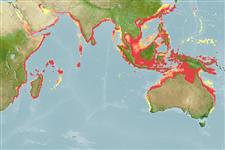Environment: milieu / climate zone / depth range / distribution range
Ecologia
marinhas; Água doce; estuarina bentopelágico; intervalo de profundidade 0 - 132 m (Ref. 57178). Tropical; 30°N - 36°S, 32°E - 155°E (Ref. 56999)
Indo-West Pacific: Persian Gulf eastward to southern China and Taiwan and northern and northeastern Australia and New Guinea.
Length at first maturity / Tamanho / Peso / Idade
Maturity: Lm 15.9 range ? - ? cm
Max length : 34.8 cm TL macho/indeterminado; (Ref. 55968); common length : 20.0 cm SL macho/indeterminado; (Ref. 9772)
Espinhos dorsais (total) : 10 - 12; Raios dorsais moles (total) : 27 - 32; Espinhos anais: 2; Raios anais moles: 7 - 8. Snout rounded but not swollen or projecting; mouth large, oblique; upper jaw extending backward below posterior half of eye; no barbel on chin; teeth in narrow bands, well differentiated into large and small in both jaws, but none canine-like; gill rakers slender, about half length of gill filaments at angle of arch, 9 to 15 on lower limb. Second anal spine moderately long, 24 to 42 % of head length. Scales on head cycloid (smooth). Swim bladder hammer-shaped, the first pair of arborescent appendages entering head beyond transverse septum and sending a palmate branch to the front of pectoral arch. Sagitta (large earstone) with a tadpole-shaped impression, the head of which has its long axis lying obliquely to that of sagitta and the tail expanded and deepened as a hallow cone connected with the head by narrow groove.
Inhabits shallow coastal waters, estuaries, and rivers. In India, matures at the size of 14 to 16 cm TL; attains an average size of 15.8 cm TL, 20.6 cm TL, and 24 cm TL, at the end of 1 year, 1.5 years and 2 years, respectively. Juveniles prefer crustaceans and as they grow , show piscivorous tendency (Ref. 9772). Marketed fresh and dried salted (Ref. 3490).
Life cycle and mating behavior
Maturities | Reprodução | Spawnings | Egg(s) | Fecundities | Larvas
Sasaki, K., 2001. Sciaenidae. Croakers (drums). p.3117-3174. In K.E. Carpenter and V.H. Niem (eds.) FAO species identification guide for fishery purposes. The living marine resources of the Western Central Pacific. Volume 5. Bony fishes part 3 (Menidae to Pomacentridae). Rome, FAO. pp. 2791-3380. (Ref. 9772)
Categoria na Lista Vermelha da IUCN (Ref. 130435)
Ameaça para o homem
Harmless
Utilização humana
Pescarias: pouco comercial
Ferramentas
Relatórios especiais
Descarregue XML
Fontes da internet
Estimates based on models
Preferred temperature (Ref.
123201): 24.6 - 29.1, mean 28 °C (based on 2424 cells).
Phylogenetic diversity index (Ref.
82804): PD
50 = 0.5000 [Uniqueness, from 0.5 = low to 2.0 = high].
Bayesian length-weight: a=0.00490 (0.00325 - 0.00738), b=3.12 (3.00 - 3.24), in cm total length, based on LWR estimates for this species & Genus-body shape (Ref.
93245).
Nível Trófico (Ref.
69278): 3.7 ±0.4 se; based on diet studies.
Resiliência (Ref.
120179): Elevada, tempo mínimo de duplicação da população menor que 15 meses (K=0.5-0.8).
Fishing Vulnerability (Ref.
59153): Low vulnerability (22 of 100).
